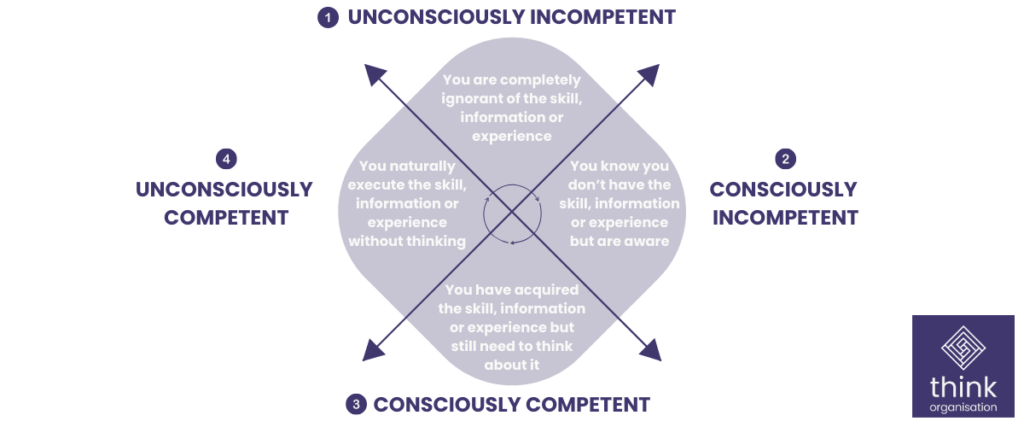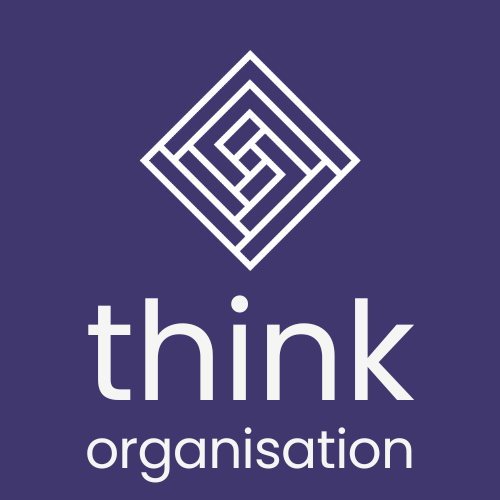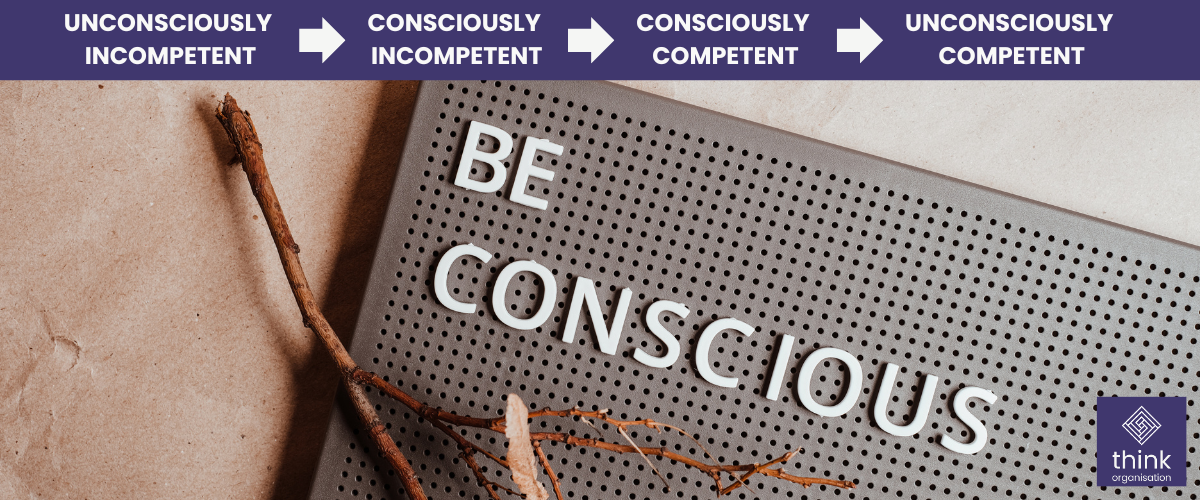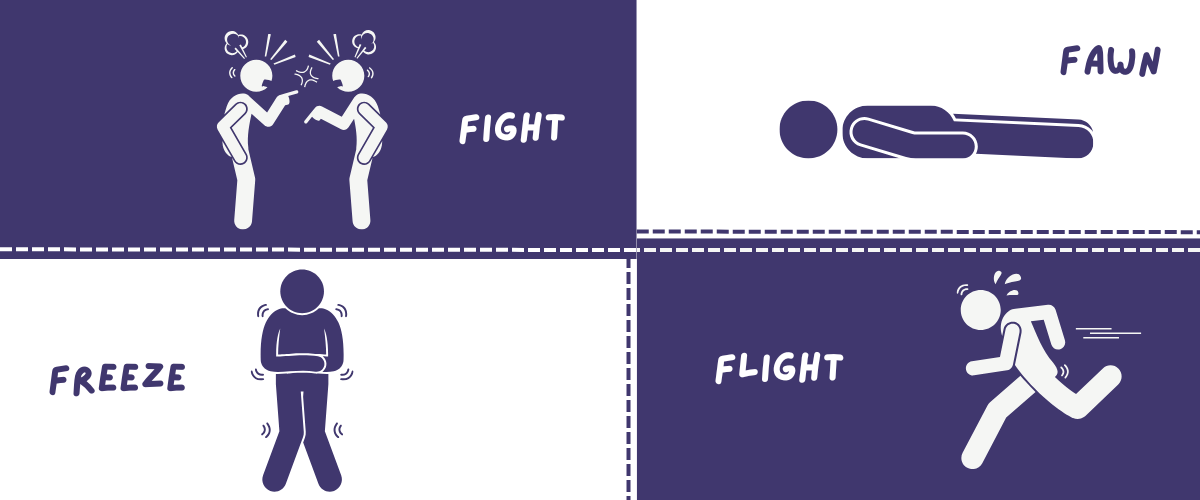The Conscious Competence model, also called the Four Stages of Competence, is a simple yet powerful way to understand how we acquire new skills and navigate any learning curve. First developed by psychologists and management experts, it is widely attributed to Noel Burch in the 1970s when it gained prominence.
The model is a clear and adaptable 2×2 framework, as shown below. It helps people understand their learning journey and at Think Organisation we often use it to take the heat out of difficult conversations. For example, during workshops, it can be useful to introduce this model when participants are grappling with challenging feedback or struggling with new concepts. Supporting individuals to identify where they think they are on the grid can be a great coaching conversation.

This model offers clarity, helping remove emotion from discussions, allowing it to become easier for people to reflect on their progress. The model shows that being “stuck” is normal and part of growth as is not knowing something.
Stage 1: Unconscious Incompetence
At this stage, you don’t know what you don’t know. There is a lack of awareness about a skill or knowledge you need. For example, as a child, you might watch your parents drive a car without considering that one day, you’ll need to learn this skill too. Questions are a powerful way to prompt awareness. By asking the right questions, we can help people move from being unaware to recognising areas for growth.
Stage 2: Conscious Incompetence
This stage is when you realise you lack a skill or knowledge. Awareness can be uncomfortable, especially when the scale of the challenge becomes clear. For instance, your first driving lesson can be overwhelming when you learn about gears, signals, and road safety all at once. The key to moving forward here is persistence. By embracing the discomfort and seeking feedback, individuals can begin to make progress.
Stage 3: Conscious Competence
Here, you’ve developed the skill, but it still requires effort and focus. In driving, this is the stage where you know what to do but need to think about it – mirror, signal, manoeuvre. This stage is about practice, reflection, and continual improvement. Feedback and support are crucial to embedding the skill.
Stage 4: Unconscious Competence
At this level, the skill becomes second nature. You can perform it instinctively without much thought. For example, experienced drivers often reach their destination without recalling every step of the journey. While this stage is ideal, it’s important to stay open to new learning and feedback to avoid complacency.
Applying the Model to Organisational Culture
This model isn’t just about individual skills; it can be a powerful tool to improve organisational culture. At Think Organisation, we often see leaders in the Unconscious Incompetence stage one when it comes to understanding their company’s culture.
Many leaders are unaware of the hidden dynamics within their organisation. Culture impacts behaviours, morale, and performance, yet its influence often goes unnoticed – like having a sign stuck to your back that only others can see.
To address this, we developed the Think Culture Measure. This tool helps leaders uncover blind spots in their organisational culture. It provides clear data and insights, moving them from unconscious to conscious awareness.
The Journey to Conscious Competence in Culture
Leaders who use the Think Culture Measure can start to see how their organisation’s culture impacts their people and performance. With this awareness, they can begin to:
- Identify areas for improvement.
- Engage employees in honest conversations.
- Create actionable plans for change.
Think of how consciously competent you or your leaders are about your team or organisational culture? What behaviours are completed unconsciously, or consciously? Have you attempted culture change but it has failed to be delivered?
Even after over twenty years working within, on and as part of organisational cultures we find very few leaders reach unconscious competence in cultural leadership. This is because every culture is unique, and it requires consistent feedback and trust. Leaders are part of the culture, so it is people who are not part of the culture who have true unconscious competence at diagnosing cultures. Ironically, leaders who claim this unconscious competence are often leading poor cultures, where employees may feel unsafe sharing the truth.
However, any leader who embraces the Think Culture Measure, or any of our other measures, can make significant progress. Measuring psychological safety, boardroom effectiveness or the culturescape of your organisation empowers leaders to become more attuned to their organisation’s dynamics. Think measures provide clarity allowing better decisions to be made, and create an environment where everyone thrives.
Why Does This Matter?
In the workplace, people have different levels of skill, experience, and competence. Some may stay at earlier stages due to personal preferences or limitations, while others strive for mastery.
For leaders, the Conscious Competence model offers a roadmap. It helps them recognise where they and their teams are on the journey and guides them to take the next step.
By applying this model, you can unlock growth—for yourself, your teams, and your organisation. Whether it’s developing new skills or transforming culture, the journey is worth it.
So, where are you on the Conscious Competence curve? And where is your organisation?
Contact us and let’s start the conversation.



